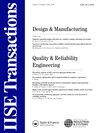新冠肺炎:基于代理的疫苗中心位置模拟优化疫苗分配问题
IF 2
3区 工程技术
Q3 ENGINEERING, INDUSTRIAL
引用次数: 2
摘要
本文提出了一种基于代理的模拟优化建模和算法框架,以确定疫情爆发期间预算约束下的最佳疫苗中心位置和疫苗分配策略。模拟和优化模型都包含了人口健康动态,如易感(S)、接种疫苗(V)、感染(I)和康复(R),而它们的综合利用则侧重于新冠肺炎疫苗分配挑战。我们首先建立了一个动态位置分配混合整数规划(MIP)模型,该模型确定了一个地理位置上每个地区的最佳疫苗接种中心位置以及在多时段环境中分配给疫苗接种中心、药店和卫生中心的疫苗。然后,我们通过添加代表接种第一针疫苗和前两针疫苗的人的新疫苗接种室,扩展了新冠肺炎(Covasim)的基于代理的流行病学模拟模型。新冠肺炎涉及复杂的疾病传播接触网络,包括家庭、学校和工作场所,以及人口统计数据,如基于年龄的疾病传播参数。我们将扩展的Covasim与疫苗接种中心位置分配MIP模型结合到一个单一的模拟优化框架中,该框架在时间上前后迭代,以确定不同疾病动态下的最佳疫苗分配。基于代理的模拟捕捉了疾病进展中固有的不确定性,并预测了当前时间段内易感个体和感染的精细数量,作为优化的输入。我们使用新冠肺炎数据和新泽西州的疫苗分配案例研究来校准、验证和测试我们的模拟优化疫苗分配模型。由此产生的见解支持正在进行的大规模疫苗接种工作,以减轻大流行对公共卫生的影响,而模拟优化算法框架可以推广到其他流行病。[发件人]IISE交易的版权归Taylor&Francis Ltd所有,未经版权持有人明确书面许可,不得将其内容复制或通过电子邮件发送到多个网站或发布到listserv。但是,用户可以打印、下载或通过电子邮件发送文章供个人使用。这可能会被删节。对复印件的准确性不作任何保证。用户应参考材料的原始发布版本以获取完整信息。(版权适用于所有人。)本文章由计算机程序翻译,如有差异,请以英文原文为准。
COVID-19: Agent-Based Simulation-Optimization to Vaccine Center Location Vaccine Allocation Problem
This paper presents an agent-based simulation-optimization modeling and algorithmic framework to determine the optimal vaccine center location and vaccine allocation strategies under budget constraints during an epidemic outbreak. Both simulation and optimization models incorporate population health dynamics, such as susceptible (S), vaccinated (V), infected (I) and recovered (R), while their integrated utilization focuses on the COVID-19 vaccine allocation challenges. We first formulate a dynamic location-allocation mixed-integer programming (MIP) model, which determines the optimal vaccination center locations and vaccines allocated to vaccination centers, pharmacies, and health centers in a multi-period setting in each region over a geographical location. We then extend the agent-based epidemiological simulation model of COVID-19 (Covasim) by adding new vaccination compartments representing people who take the first vaccine shot and the first two shots. The Covasim involves complex disease transmission contact networks, including households, schools, and workplaces, and demographics, such as age-based disease transmission parameters. We combine the extended Covasim with the vaccination center location-allocation MIP model into one single simulation-optimization framework, which works iteratively forward and backward in time to determine the optimal vaccine allocation under varying disease dynamics. The agent-based simulation captures the inherent uncertainty in disease progression and forecasts the refined number of susceptible individuals and infections for the current time period to be used as an input into the optimization. We calibrate, validate, and test our simulation-optimization vaccine allocation model using the COVID-19 data and vaccine distribution case study in New Jersey. The resulting insights support ongoing mass vaccination efforts to mitigate the impact of the pandemic on public health, while the simulation-optimization algorithmic framework could be generalized for other epidemics. [ FROM AUTHOR] Copyright of IISE Transactions is the property of Taylor & Francis Ltd and its content may not be copied or emailed to multiple sites or posted to a listserv without the copyright holder's express written permission. However, users may print, download, or email articles for individual use. This may be abridged. No warranty is given about the accuracy of the copy. Users should refer to the original published version of the material for the full . (Copyright applies to all s.)
求助全文
通过发布文献求助,成功后即可免费获取论文全文。
去求助
来源期刊

IISE Transactions
Engineering-Industrial and Manufacturing Engineering
CiteScore
5.70
自引率
7.70%
发文量
93
期刊介绍:
IISE Transactions is currently abstracted/indexed in the following services: CSA/ASCE Civil Engineering Abstracts; CSA-Computer & Information Systems Abstracts; CSA-Corrosion Abstracts; CSA-Electronics & Communications Abstracts; CSA-Engineered Materials Abstracts; CSA-Materials Research Database with METADEX; CSA-Mechanical & Transportation Engineering Abstracts; CSA-Solid State & Superconductivity Abstracts; INSPEC Information Services and Science Citation Index.
Institute of Industrial and Systems Engineers and our publisher Taylor & Francis make every effort to ensure the accuracy of all the information (the "Content") contained in our publications. However, Institute of Industrial and Systems Engineers and our publisher Taylor & Francis, our agents, and our licensors make no representations or warranties whatsoever as to the accuracy, completeness, or suitability for any purpose of the Content. Any opinions and views expressed in this publication are the opinions and views of the authors, and are not the views of or endorsed by Institute of Industrial and Systems Engineers and our publisher Taylor & Francis. The accuracy of the Content should not be relied upon and should be independently verified with primary sources of information. Institute of Industrial and Systems Engineers and our publisher Taylor & Francis shall not be liable for any losses, actions, claims, proceedings, demands, costs, expenses, damages, and other liabilities whatsoever or howsoever caused arising directly or indirectly in connection with, in relation to, or arising out of the use of the Content. Terms & Conditions of access and use can be found at http://www.tandfonline.com/page/terms-and-conditions .
 求助内容:
求助内容: 应助结果提醒方式:
应助结果提醒方式:


